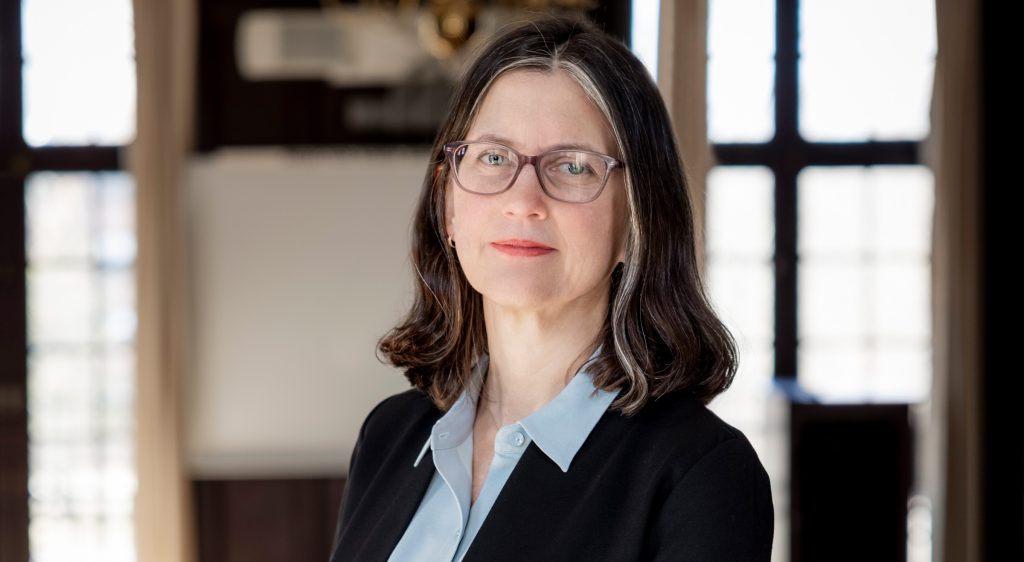As men convened in Philadelphia to draft the United States Constitution, there was a voice they could not have missed. It was the voice of Eliza Harriot Barons O’Connor, a woman born of British gentry who was also in Philadelphia, giving public lectures and drumming up business for her new academy dedicated to the education of women. In Female Genius: Eliza Harriot and George Washington at the Dawn of the Constitution (University of Virginia Press), author Mary Sarah Bilder presents Eliza Harriot’s remarkable life, and how her ideas may have influenced the decision of its drafters to use gender-neutral language throughout the Constitution.
Bilder is the Founders Professor of Law at Boston College Law School. Her 2016 book Madison’s Hand: Revising the Constitutional Convention, earned the Bancroft Prize in American History and Diplomacy, and was a finalist for the George Washington Book Prize. Her 2004 The Transatlantic Constitution: Colonial Legal Culture and the Empire won the American Historical Association’s Littleton-Griswold Award. Here, she offers a glimpse into what the study of Eliza Harriot’s life reveals about American history.
BC Law Magazine: Why Eliza Harriot?
Mary Bilder: Throughout all the time that I’ve been working on the Constitutional Convention, I kept coming back to a funny entry in George Washington’s diary from when he was in Philadelphia in the summer of 1787. As he’s waiting for the convention to start, he writes about going to see a lady lecture at a college hall. And I just was like, who is that? What is she doing there? What does it mean that he goes to see her? For me, Eliza Harriot was both this mystery and also this way of expanding our understanding about women and gender in connection with the framing period.
Q: You note that digital technology made your inquiry into Eliza Harriot possible. How so?
A: Eliza Harriot had no children. Her only surviving writings are a handful of correspondences with George Washington and the newspaper ads and promotional newspaper commentary that she placed to attract students to her schools. Digital technology made it possible for me to find hundreds of her ads and commentary across several states. More generally, digital technology makes it possible to see how, in the late 18th century, newspaper editors picked up interesting material from other newspapers and reprinted them. In an 18th century way, Eliza Harriot’s ideas went viral. And so that changes our understanding of her impact.
Q: What does Eliza Harriet’s position in the economy and culture tell us about this time?
A: In the late 1770s and 1780s, on both sides of the Atlantic, you can see the emergence among various writers and thinkers of this idea of “female genius.” Female genius meant that women should not be considered inferiors; that they should be educated for their own sakes, not just for the sake of their husbands, and that their education would make them capable of participating in politics, in representation, in holding office, of being fully involved in the constitutional state. The kinds of exclusions from political participation that came about in the 19th century weren’t yet in place. Eliza Harriot embodies this idea of female genius.
But her story also reminds us of the ever-present reality of race-based enslavement. She configures herself as a lady, a term that in this period is associated with white women. She constantly moves south, and her success there is probably based on her ability to succeed in an economy dependent on enslaved labor.
Q: What did you learn from researching and writing this book?
A: A lot of the book takes pieces of history and explains how they fit together. I knew of Mary Wollstonecraft [British author of A Vindication of the Rights of Women (1792)]. I knew there was female education. I knew that women and African Americans had voted in New Jersey. But for me, they were all in separate boxes. Part of what I’m trying to do in the book is to show that all these separate boxes are actually part of the same story.
Q: What is that story?
A: There is a standard narrative of American history that there is a natural order of how people get included in the constitutional state over time. But if we track constitutions and voting statutes, we see a shift from the more inclusive language that was dominant at the time of the framing to language that excludes all but the white male citizen voter. That’s not a story of ever-increasing inclusion. It’s a story of inclusion yielding to exclusion. In New Jersey, women were included and then they were excluded because people thought they voted for the wrong political party. People used arguments of voter fraud to argue that they should be excluded. There are real parallels to today around that. That’s a very different way of thinking about it.
Q: What does Eliza Harriot add to this story of struggle between inclusion and exclusion?
A: When we bring Eliza Harriot into the story, we can see her presence in Philadelphia the summer of the Constitutional Convention, giving lectures, suggesting a female-led academy, and disseminating her ideas in newspapers. And we can see that early drafts of the Constitution had gendered references, and that those were taken out and the Constitution is rendered gender-neutral in an 18th century sense. And why is that? We can’t completely know, but if you understand that her presence that summer is bringing with it these ideas from a trans-Atlantic movement, then we can think, well, maybe the Constitution was designed to be, or was at least open to, the possibility of female genius.
Interview conducted, edited, and condensed by Jeri Zeder.


